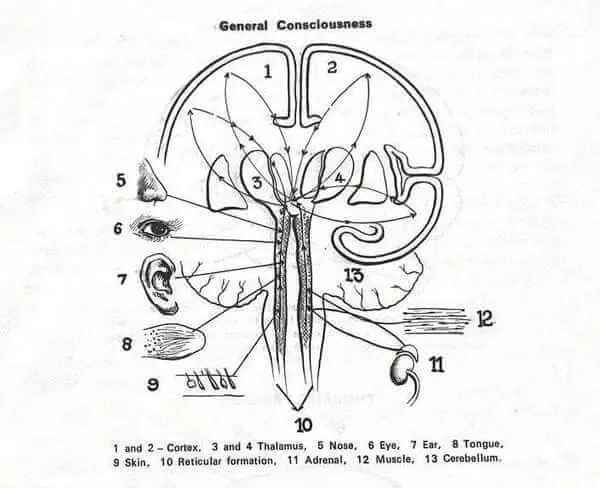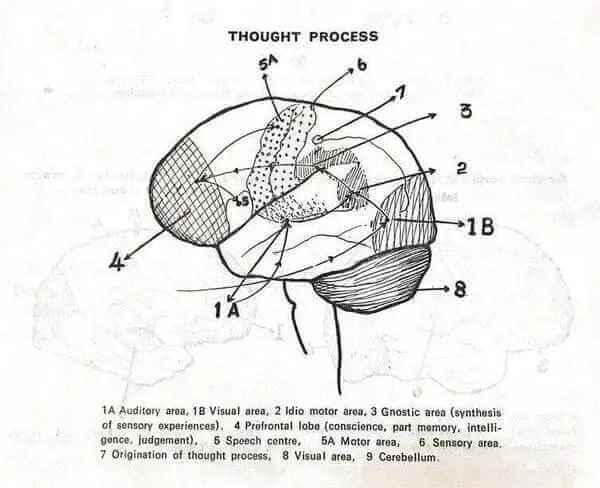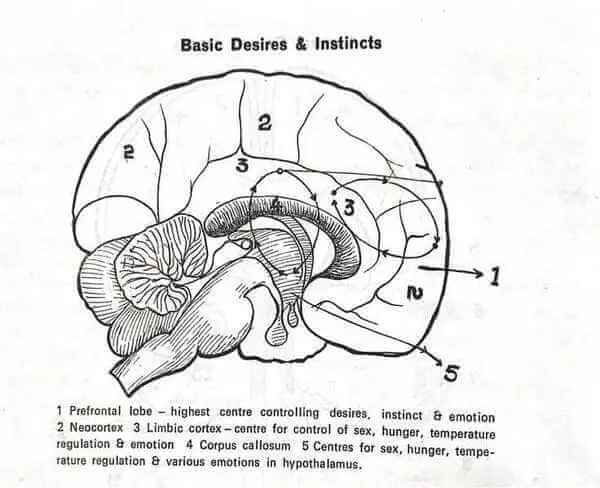Author: Randeep Singh / go to all articles on Yoga Concepts

Generally, one hardly feels the need
to distinguish brain from the mind,
as these two terms appear synonymous
in day today living.
For any student of yoga, who has a persistent
craving for clarity on all phenomenon,
by that are associated with his/ her existence,
the debate on mind vs brain is an absolute necessity.
Yoga advocates deep understanding of the working of the mind,
so that one can work towards deleting the mind once for all in order to experience the pure consciousness, or the Purusha.
Mind is an obstacle in the path of experiencing pure consciousness. Yogis knew this forever, but the basic tenets of the mind vs brain debate began to upwell only after the developments in the field of neuroscience began to emerge. Before we dwell deeper, to test your knowledge about brain, would be a real eye opener.
If mind and brain are one and the same thing than how come thinking as a process remains unaffected even when a part of the brain is removed with surgery ( as in patients of severe epilepsy)/ how can people with their brains dead (
as in coma) still continue thinking, how come creatures which do not possess a fully developed brain, amoeba or a flatworm, exhibit complex behavior?
The mind is not a physical entity as the brain is, the mind is supposed to be a matrix of thoughts, composed of energy, which operates independent of the physical brain. The mind is not known to reside, or operate out of any physical organs of the body, like the brain. The brain on the other hand, as per yoga, along with its extensions into the nervous system is the physical expression of the mind.
Mind and Brain, Anatomy and Physiology Relationship
The entire universe is made up of inanimate objects and the living organisms. The living organisms in their natural state have two basic properties.
- Consciousness or awareness of surroundings.
- Ability to react to the environmental stimuli.
The character and scope of both these properties vary in different organisms. Humans get to know the world around them through the five organs of perception: eyes. ears, nose, tongue and the skin (jnanendriyas).
The reaction to the external stimuli takes place in the form of contraction or relaxation of the voluntary and involuntary, muscles, and via secretions from various glands. The five organs of action , karmendriyas, help us to act appropriately.
As per Yoga the life principle lies in the soul or the Purusha. The organs of perception and action help the mind to acquire knowledge of the surroundings for the purpose of presenting it to the soul, individual spirit, which is the ultimate knower.
Mind and the Brain: Process of Acquiring Knowledge

For acquiring knowledge it is necessary that the sense organs establish contact with their objects: eyes must look at the object. The information received by the sense organs in this manner is relayed to the respective sensory centers in the brain via the connected nerves. The brain has the primary sensory areas like visual cortex and auditory cortex etc. where one actually perceives the sensations of sight and hearing.
Secondary sensory areas exist around the borders of the primary sensory areas which help interpret the information received at the respective primary sensory areas inside the brain. Damage to these areas results in loss of interpretation e.g., word blindness or word deafness etc. The sensory information so received by the primary sensory areas of the brain help generate the phase of wakefulness.
A set of nerve fibers known as reticular formation are present in the parts of the brain known as medulla, pons, midbrain, thalamus and hypothalamus. These reticular formations receive the sensory information from the sense organs via the primary sensory areas. The thalamic portion of the reticular formation sends facilitatory signals to all parts of cerebral cortex resulting in the phase of wakefulness.
Mind vs Brain – Wakefulness
In this state one has general awareness of the surroundings. One is able to see a scene, hear the cawing of a crow and get the gentle feel of the breeze simultaneously. The mind is not focused on any particular object nor is it engrossed in thinking. However, the mind is making momentary contacts with various sensory areas in rapid succession and thus has a general sense of awareness of the entire surroundings.
After a certain period of wakefulness and activity the centers in the reticular formation get fatigued, and the person falls asleep. Thus wakefulness is the function of the mind which is generated by the activity of the physical brain, So, inspite of the mind vs brain concept,the mind and the brain are functionally connected to each other.
Mind and Brain – Attention
Attention is a function of mind. The degree of attention can vary:
- No attention i.e. when mind is not working at all. In this state even if the sensory stimuli in secondary sensory area one is not aware of them.
- General attention as explained in the phase of wakefulness.
- Intense attention and concentration.
Stimulation of selective points or a single specific area in the thalamic portion of reticular activating system generally activates only a specific area of the cerebral cortex. Cerebral cortex is the area of the brain where the conscious awareness, wakefulness, of the surroundings is created.
Due to this ability of being able to excite specific regions of the cortex by specific excitation of the thalamic region the person can direct his attention to a specific aspect of his mental environment, which could be either immediate sensory experience or a stored memory.
The sensory organs feed the thalamic portion of the reticular formation with the respective information like a input unit, keyboard, feeds information in a computer. The scanning, which information to be sent to the cortex, of this information is done by the thalamus and the processing of the information is done by the cortex.
The multiple coming from the thalamus which hit the cortex and create the state of general consciousness can be restricted to specific signals in order to keep the state of consciousness, attention, only on a single theme.
This is concentration of the mind, or maintaining one’s attention on a single aspect. Thus the functions of the physical brain help create the state of mind known as attention or the phase of wakefulness.
Intellect, Memory, Conscience: Brain and Mind Relationship
In relation to the debate on mind vs brain, intellect, memory, and conscience are the components of mind, though mind works as a one functional unit.
Intellect: Brain and Mind Relationship
Intellect (budhi as per Samkhya) is the instrument of acquiring knowledge. The primary functions of Intellect are:
- To think, concentrate and memorize.
- To analyze and reason.
- To differentiate between good and bad, right and wrong.
- To decide whether one should get involved in a deed or not.
- To anticipate the consequences, complications, and risks involved in a deed.
- To have the capacity to adapt, speak and act accordingly.
- To comprehend the effects of one’s actions and speech.
- To guide the self as to whether one’s thoughts and actions are helping one to develop into a better or worse person.
The crux is that common sense is the function of the intellect.

Thought process originate in the posterior tip of the lateral fissure of brain where temporal, auditory, and occipital lobes come together through superior, temporal, and angular gyri.
The intellectual functions are performed majorly on the dominant side of the cerebral cortex’s hemisphere. It is in this area one can arrange the data into coherent thought. When this area is damaged one can understand the meaning of each word but not of the thought conveyed.
This happens because one is unable to interpret the meaning of sensory information. This center also stores recent memory. When both temporal lobes are damages the person cannot recall the simplest of recent events, but can recall distant past events enrooted in the mind.
Determination of the sequence of sentences or speech is done by the speech center situated close to the intelligence center.
The highest centers of intelligence (buddhi) are situated in the pre frontal areas of the brain. The functions of these centers are concentration of mind, elaboration of thoughts, future planning, solving mathematical problems, handling philosophical issues. These centers also enable one to take important and complicated decisions and consider the sequence of speech and motor actions before their execution.
Memory: Brain and Mind Relationship
Patanjali defined memory as recollection in the exact manner of previously experienced events or objects. The faculty of intellect by which one can recall past events is termed as memory.
Memory is the capability of recalling a thought, event, or theme at least once and usually again and again. Memories are triggered when the nervous system create the same pattern of stimulation at a future date.
Instantaneous memory is the ability to recall the details of a scene, which was of no interest to the person, for a minute or even after an hour. Fixed memory is the ability to recall an event, which matched one’s interest, even days later.
In instantaneous memory sensory stimulation of the cerebral cortex sets up similar reverberating oscillations which continue for many minutes till the circuit get fatigued and the memory fades.
Fixed memory results from actual alteration of synapse ( meeting point of two neurons which connect in a relay to form a nerve). The changes may be physical or chemical in nature. The hippocampal zone is the site of recent memory and large parts of neocortex are concerned with long term memories.
The association areas of the various sensory centers mainly serve as store houses of long term memories. The long term memory traces are also stored in multiple locations along the nervous system.
The corpus callosum and anterior commissure can transfer memory from one brain hemisphere to another. There are many indications that intracellular protein synthesis involving RNA may play a vital role in long term memory. An alteration has been noted in the two out of four amino acids forming the RNA (adenine increased and uridine decreased) as the memory imprints are formed.
Experiments have established that the RNA extracted from a group of rats trained on a particular task when injected in the untrained group of rats induced the second group to perform the same tasks without any training.
If RNA carries memories, genes and chromosomes which are composed of RNA and DNA can certainly carry experiences and memories across generations.
The reward and punishment centers in the hypothalamus have much to do with controlling the type of information and memory we have. We remember those events which affect us or involve us directly or indirectly as pleasure or pain.
Conscience represents the faculty of the brain which tells us what is right and wrong, good or bad, and accordingly guides our activities and mental processes. The centers of conscience or moral arm of the personality are situated in the prefrontal lobes.
Behavior and Emotions: Mind and Brain

Behavior is a function of the entire nervous system, and not of any part of it. Even the discrete cord reflexes are an element of behavior. The affective quality of behavior is associated with intrinsic feelings of pleasure and pain also known as reward and punishment.
These functions are mainly performed by hypothalamus and the adjacent areas, as well as the older portions of the cerebral cortex namely amygdaloid nucleus, hippocampus, cingulate gyrus and medial and ventral portions of cerebral cortex. This over all group of structures is known as the limbic system.
Hypothalamus and related structures are concerned with discerning whether the sensory inputs are pleasant or painful. The center for reward is situated in the ventromedial nucleus of hypothalamus.
Stimulation of this center soothes the being and results in the feelings of joy and satisfaction. Reward is also a primary protective mechanism. If one gets food one feels happy and the reward mechanism comes into play.
The center of punishment extends from periventricular areas in dorso medial part-tegmentum of midbrain to periventricular area of hypothalamus, thalamus, and perifornicular nucleus. Stimulation of perifornicular nuclei cause rage. More rostral areas of punishment center i.e. midline preoptic and septal areas when stimulated result in fear and anxiety.
Stimulation of this center also causes pain defence and escape reactions. The pain or punishment center has primary protective mechanism, and hence pain normally dominates over pleasure, punishment over reward.
It has been found that sensory experience which causes neither reward not punishment is hardly remembered at all. If associated with pleasure or pain the response is reinforced and the being builds memory imprints.
Thus wand punishment centers have a role to play in the controlling the type of information we learn. If one feels pleasure in doing something one keeps repeating it and vice versa.
The development of various desires and aversions depends on pleasure and pain associated with various experiences. Hypothalamus also controls sympathetic and parasympathetic activities and thus controls changes in heart rate, blood pressure, perspiration etc., associated with various emotions. Stress situations stimulate the secretion of hormones like cortisone and thyroxine by affecting the anterior pituitary and hypothalamus.
Disturbances produced in hypothalamus can cause uncontrolled anger reaction termed as sham rage. uncontrolled rage can be fatal sometimes. This can also cause outbursts of uncontrolled laughter or crying, disorders of sleep rhythm, and disorders of sexual function.
Where is the Mind Located?
After going all the elaborate debate on mind vs brain above one is still left wondering, where is the mind located? Mind is a functional unit and operates at various levels in humans as illustrated below.
Functional components of mind
- Consciousness or general awareness / located in reticular formation together with cortex at the anatomical level in brain.
- Pleasure and pain / located in reward and punishment centres in hypothalamus together with cortex at the anatomical level in brain.
- Desires and aversions, instincts and emotions / located in hypothalamus along with limbic cortex at anatomical level in brain
- Thinking and concentration / stimulation of a specific circuit in reticular formation and cortex together with inhibition of other circuits at anatomical level in the brain.
- Intellect / located at the posterior tip of lateral fissure together with cortex and prefrontal lobes
- Memory / located at hippocampal zone with extensive parts of neo cortex at anatomical level in brain.
- Conscience / located at prefrontal lobes at anatomical level in the brain.
These various levels of mind operate in collaboration with each other in a normal person. The entire nervous system along with mind operate as one functional unit.
According to Indian Philosophy , Mind has four components. These components along with their functions are given below.
Components of mind, meaning, and function
- Mana – thought center – thinking, awareness, reasoning, doubting.
- Ahankara – ego – self awareness and pride.
- Buddhi – intellect – decision making and intellectual functions
- Chitta – memory centre – Memory
Thus, from the mind vs brain debate we can understand that the brain represents the seat of mind, but functionally mind pervades the entire body trough the nerves. That is why when one experiences pain in a particular part of the body, one’s attention or mind is all the time focused at that part. Moreover, through the sense organs and thoughts mind can reach and penetrate anything and everything in the universe.
Conclusion: The brain has a physical existence like other organs of the body where as the mind has its existence more at the metal level. Mind functions through the brain and the entire nervous system. Though it has an independent existence from brain the basic raw material which constructs the mind – sensory inputs – come via the brain from the various sense organs. Each functional level of mind has its counterpart at the anatomical level in the brain.
Book a Free Trial Online Yoga Class
Read other Informative Articles….
